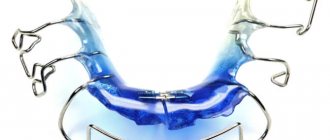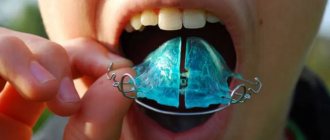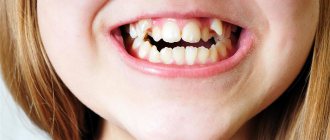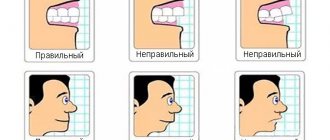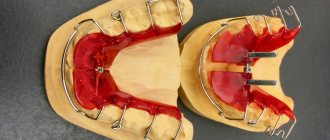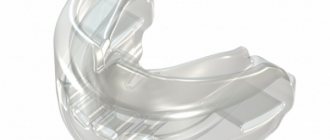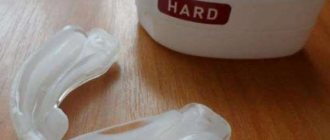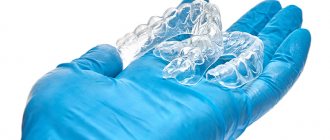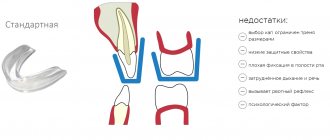What are dental plates?
An orthodontic plate for teeth is a removable structure made of soft plastic and wire. This device is made individually from hypoallergenic materials and is not traumatic to the oral mucosa. Plates for straightening teeth can be either single- or double-jawed, depending on the diagnosis. They can be supplemented with a “hand-shaped process”, which is used to move only one tooth. The device may also contain a retraction arch designed to correct the position of the front teeth. Separate types of plates for teeth are Brückle and Frenkel devices. Look at the photo below to see what the plate looks like on your teeth.
Under what conditions should braces be installed?
Braces should be installed if:
- A teenager has problems with his jaw. And also with its development.
- The teenager's front teeth had shifted significantly. And they looked sideways.
- The teenager's profile was deformed. And the face began to have incorrect proportions. Due to crooked teeth.
- The molars began to develop incorrectly. Not in accordance with prescribed standards.
- Some teenagers' teeth are too long. And others are too short.
Braces prevent your teenager from continuing to develop a malocclusion. They can modify irregularities found on a teenager's teeth. And bring them to the right state. Make sure your teeth are healthy.
When you take your teenager to the dentist, be sure to listen to his recommendations. If he advises a teenager to use braces, then install them. If it’s a record, then give preference to it. The specialist has a better idea of which treatment method will be more effective for the teenager.
Types of dental plates
Depending on the diagnosis, the doctor determines the types of dental plates. In some cases, only a plate is installed for the teeth of the lower jaw. This design refers to mechanically operating devices, that is, its action depends on the elasticity of the component parts. They use the force of an orthodontic screw, wire, ligature, or rubber ring. To increase space in the dentition at the stage of mixed dentition, an expanding plate for the teeth of the upper jaw, based on a Bertoni screw, is also used. The screw is installed on the working model of the jaw in the deep part of the dome of the palate so that it is parallel to the occlusal plane. This design needs to be tightened from time to time; we will tell you how to do this a little later.
Plastic surgery for lower jaw teeth
Upper jaw plate
When should a plate be placed on a child’s teeth?
The dental plate is not suitable for adult patients. This is an exclusively children's orthodontic device. First of all, plates for straightening teeth in children are used up to 12 years of age. During this period, there is active growth of the jaws, which makes it possible to quite effectively correct the bite, eliminate crowding and remove other occlusion anomalies. When the jaw bones have formed, it is only possible to align the teeth within the dentition. And correction of bite in adult patients is only possible with the help of braces and orthognathic surgery. In this regard, parents should not delay visiting a specialist, even if it is a preventative one, if treatment is not required. Orthodontists recommend placing a plate on a child’s teeth to achieve the following treatment goals:
- correction of jaw shape;
- regulation of jaw growth;
- correct placement of incisors in a row;
- increasing or decreasing the size of the sky.
Manufacturing and design features
Making plates to correct a bite is not an easy process, requiring a preliminary x-ray examination of the dentition. In addition, it is preceded by taking impressions and making control models. By conducting a preliminary assessment using them, the orthodontist decides how accurate the model is and whether it is suitable for the patient. If necessary, correction and re-fitting are carried out.
Plastic is used to make the base of the plate. The shape of the base exactly repeats the relief of the dental contour and gum surface. The base itself is durable and moderately rigid. The arc of the plate is made of steel wire and has hooks that are fixed on the cutters. As the position of the teeth changes and the jaw grows (when it comes to a child), the system is corrected.
How to place a plate on a child’s teeth?
Installing plates on children's teeth usually takes several weeks, since they are made individually for each patient. To create a suitable orthodontic appliance, the patient undergoes an X-ray examination, then the doctor takes an impression of the teeth for the plate. After this, plaster models are made, from which the structures are created. Particular attention is paid to the exact match of the surface relief of the gums and the palate - the adjustment takes just over 10 minutes. After this, the child will be able to independently remove and put on the plate on the lower teeth and upper jaw.
Pros and cons of this leveling method
Today, such corrective systems are very popular in pediatric orthodontics. According to reviews from doctors and parents, they are indeed very effective in practice. Among the indisputable advantages of this method are the following points:
- an excellent opportunity to eliminate minor defects of the dental system in a fairly short time,
- comfort during treatment, due to the ability to remove the device while brushing teeth and eating,
- high production speed, because the creation of a system takes no more than a week, while the preparation of fixed devices requires 2-4 weeks,
- absence of severe pain during the adaptation period, as often happens with braces,
- affordable cost, which is several times lower than the price of treatment using a fixed structure.
Of course, the treatment method under consideration has its drawbacks, and the main one is the inability of a removable corrective device to correct complex anomalies. In addition, to achieve a visible effect, the child must constantly wear the plate in his mouth, but parents do not always have the opportunity to closely monitor this and control how obediently he follows the doctor’s instructions. Otherwise, this is a truly effective and at the same time gentle option for orthodontic treatment, which has already proven its effectiveness in practice.
How long do you wear plates on your teeth and how to wear them?
The main problem with this type of treatment is that children need to wear removable dental plates 22–23 hours a day. The course of treatment can last from a year to a year and a half, with replacement of the structure required every 6 to 8 months. Like any orthodontic device, plates for baby teeth require some getting used to. Children often complain that their teeth hurt from the plate; this is normal. Usually the discomfort disappears 5 to 6 days after installation.
Wearing dental plates often confuses children, but it is worth explaining to the child that they are less noticeable and more comfortable than metal braces, which will have to be worn in adolescence without timely treatment. Children's dental plates are often made of plastic in bright colors so that the child enjoys wearing them.
Plates for correcting “milk bite” for the youngest children
The bite can also be corrected for young children. There are a number of orthodontic plates for this purpose:
plate with a wire shutter - used to correct an open bite, when when the jaws are closed, there is a gap between them;
a plate with a special “bead” - a design that is used in case of incorrect position of the tongue, and, consequently, pronounced speech defects;
classic plastic plate - recommended for frequent mouth breathing (breathing correctly - through the nose), the habit of thumb sucking;
vestibular with a special element in the form of a visor - with underdevelopment of the lower jaw due to thumb or pacifier sucking.
The need to correct the bite of children with primary teeth is determined by a pediatric orthodontist. As a rule, this is necessary for genetic predisposition, jaw injuries, obvious orthodontic deviations, which are easier and faster to correct at this age. Plates for small children are equipped with special plastic holder rings to prevent accidental passage of the plate.
How should you wear the record? Basic rules and expert recommendations
The approximate period of correction using a plate ranges from several months to two and a half years.
Most of the time, the vestibular plate is in the mouth: always at night, as well as during the day with breaks for meals. The approximate total time the tablet remains in the mouth is 20-23 hours.
While the patient is eating or performing dental hygiene procedures, the plate is placed in a special container with liquid. It is always washed after removal from the mouth and before insertion.
The record should be thoroughly cleaned daily as part of standard hygiene rituals to prevent plaque from forming on the metal and plastic parts.
How to tighten a dental plate?
The twisting procedure is necessary to increase the load, as well as expand the main surface of the plate, which is installed on the upper jaw. Your doctor will tell you how to tighten the dental plate and how often to do it. The process itself is not too complicated: using a key inserted into the main hole of the screw, one turn is made along the guide arrow on the tooth plate. After this, the child may feel discomfort for some time, but this procedure is necessary to achieve the desired result. In addition, if necessary, the plate can be returned to its previous position by turning back.
Dental plastic with a key for twisting
Why wear a removable plate?
The bite treatment plate allows you to:
- create enough space for the free eruption of molars - this will help avoid crowding of teeth and other occlusion pathologies;
- achieve a gradual expansion of the dental arch - cure the Gothic palate;
- adjust the position of the teeth - correct possible tilt of the crowns, correct rotation, etc.
The need for malocclusion treatment with a removable children's dental plate is determined by the orthodontist after:
- examination of the oral cavity;
- collecting anamnesis (the orthodontist asks parents questions about the course of the mother’s pregnancy, type of feeding, possible chronic diseases, lifestyle features, etc.);
- snapshot of the jaw.
How to care for a dental plate?
When wearing a removable structure, the child needs to handle it carefully and avoid damage or loss, as well as properly care for it. You need to remove the plate from your teeth before each meal and be sure to clean it every day with a special brush and gel. It is better to store records in a container. Particular attention must be paid to the little patient’s own oral hygiene. That is why dentists usually give a short lecture to the child, in which they explain all the rules for handling this structure.
Container for dental plates
At what age can you get braces?
Braces can be installed at absolutely any age. Not only for teenagers and adults, but also for children. At the same time, they can be used to correct any type of bite. From the simplest situations to the more complex.
A teenager will have to wear braces for a long time. From six months to two years. Interestingly, the treatment of children’s teeth is faster than that of adults. Therefore, if you notice problems with a teenager’s teeth, contact the clinic immediately. And install braces. It is much easier to correct a teenager's bite in childhood.
Plates or braces for teeth?
This choice cannot stand - dental plates and braces have different functions. The former affect the entire dentition, the latter have a wide range of functions and solve various orthodontic problems: from the curvature of individual teeth to malocclusion and crowding. Also, the plate cannot be placed if the child has developed traumatic periodontitis, in which a fracture of the cortical plate of the tooth is possible. However, these two devices can be used in combination - first the child will be given a plate, and then braces.
Indications for installation of orthodontic plates
The main indications for the installation of orthodontic plates for children are:
· adjusting the distance between teeth and eliminating gaps (diastemas and threes) between them;
· change in the width of the sky;
· acceleration or deceleration of jaw growth, as well as correction of its shape (for example, eliminating narrowness);
· displacement of incorrectly located teeth and their fixation in the right place;
· preventing further curvature (crowding) of the dentition;
· correction of the bite and prevention of relapses of its violation.
The cost of a dental plate in Moscow
The average cost of dental plates for children in Moscow varies from 8 to 15 thousand rubles. Do not forget that the design requires periodic correction and replacement, so visits to the doctor must be included in the total cost. You should also take into account other factors that affect the price, for example, the level of pediatric dentistry and the qualifications of specialists. In any case, you shouldn’t go after cheapness; the cost of dental plates for children should not be too low - the child’s health is more expensive.
Until what age is it recommended to have braces?
It is recommended to install braces until the age of twenty-five. Until this age, a person’s teeth are actively growing. And they develop. It is easier for children to correct them than for adults.
When a person reaches twenty-five years of age, this can lead to serious problems. The tissue may become very stiff. As a result, the teenager's jaw will be formed. And it will be very difficult to correct the bite. After putting on braces, a teenager will have to have his teeth treated for a very long time. You will have to wear braces for 24 months or more.
It is not recommended to get braces after twenty-five years of age. Because there is a risk that you will have to wear the plate for the rest of your life. To keep your teeth straight.
